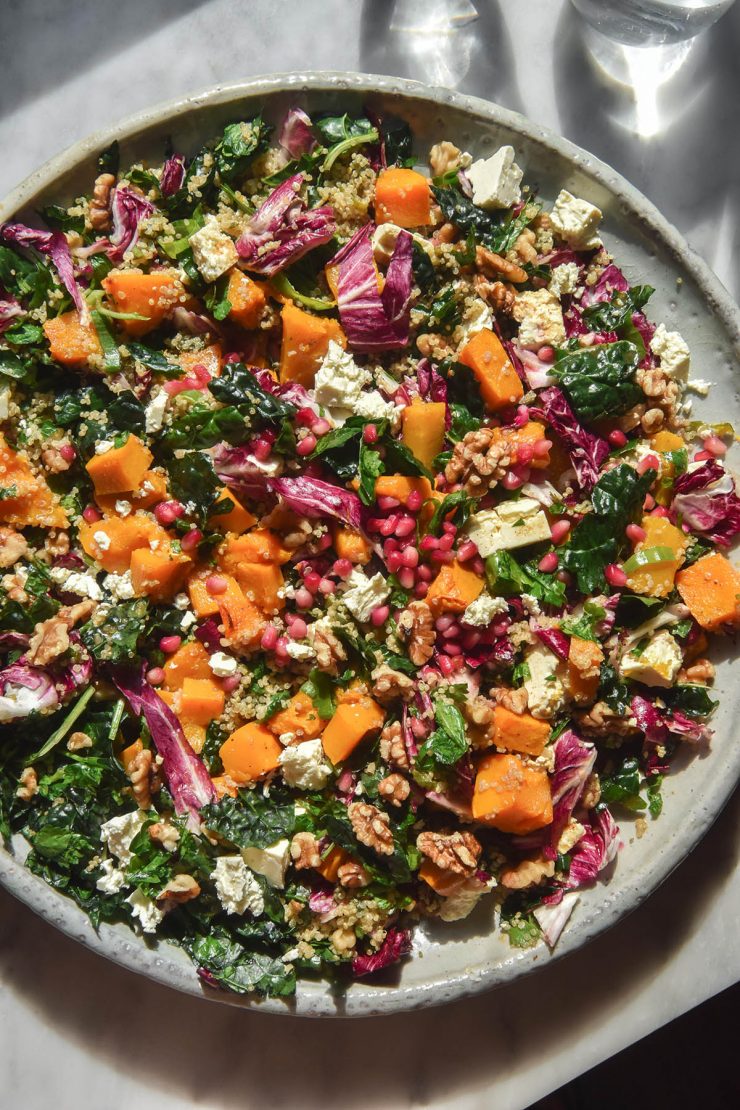
If you’re thinking that this recipe looks similar to another pumpkin recipe of mine: good eye. I was tasked with making an entertaining salad recently, so I wanted to bring the best of the best together. A little of one pumpkin salad, a little of another. Think of this recipe as the All Star roasted pumpkin salad on my site.
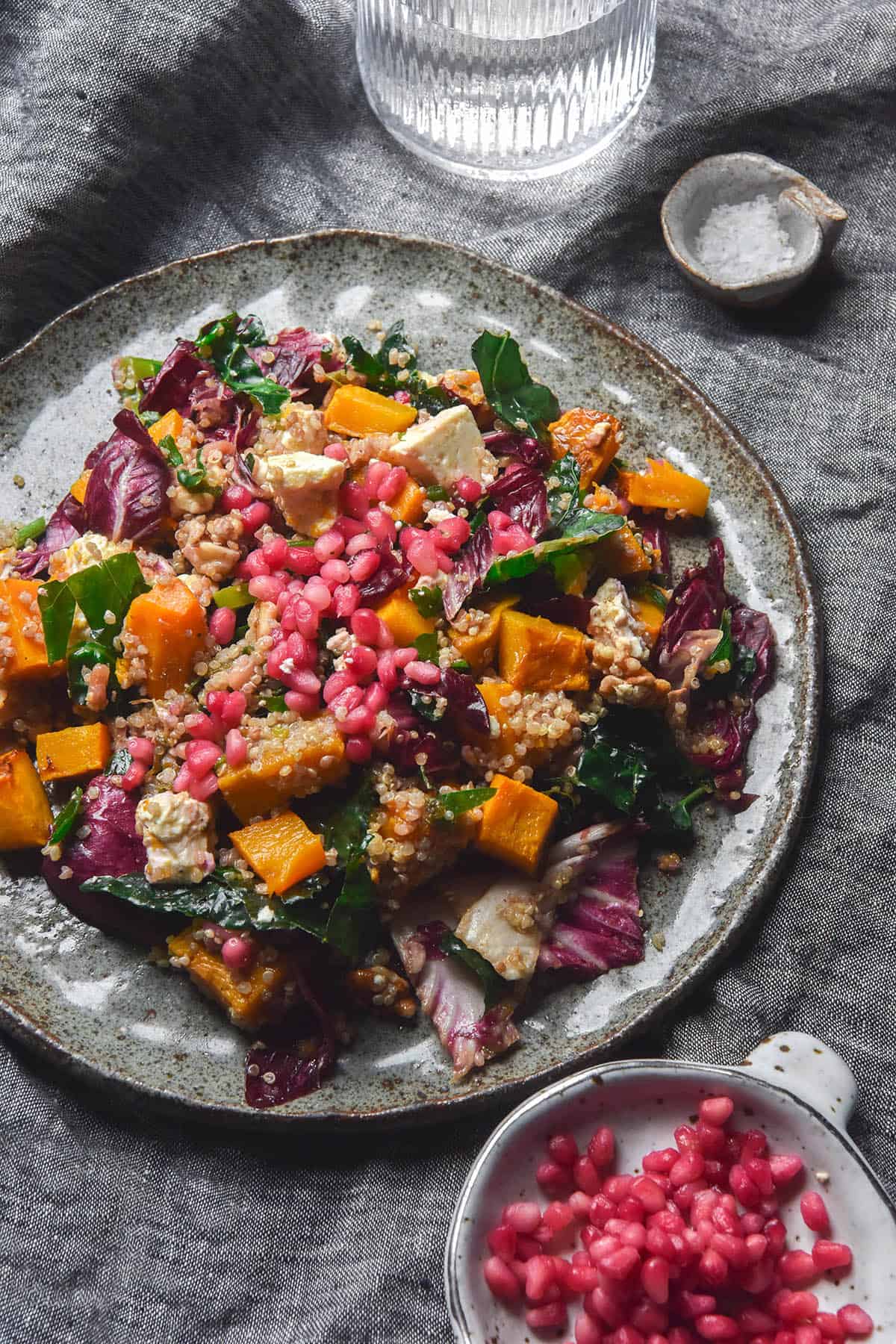
Roasted pumpkin salad with quinoa, pomegranate and feta
The title of this recipe doesn’t really do it justice, so let’s delve in a little further. This is a roasted pumpkin salad with feta, quinoa, walnuts, pomegranates, kale and parsley (plus a little radicchio). It is dressed with a citrusy, Christmas spiced dressing for the ultimate festive salad.
The salad is vegetarian, gluten free, low FODMAP and easily made vegan. It can also be made nut free by substituting out the walnuts.
Another bonus is this salad can easily be made ahead. You can also make the components ahead and assemble the salad on the day. It keeps well in the fridge and is nice and filling. The perfect dish for the entertaining season.
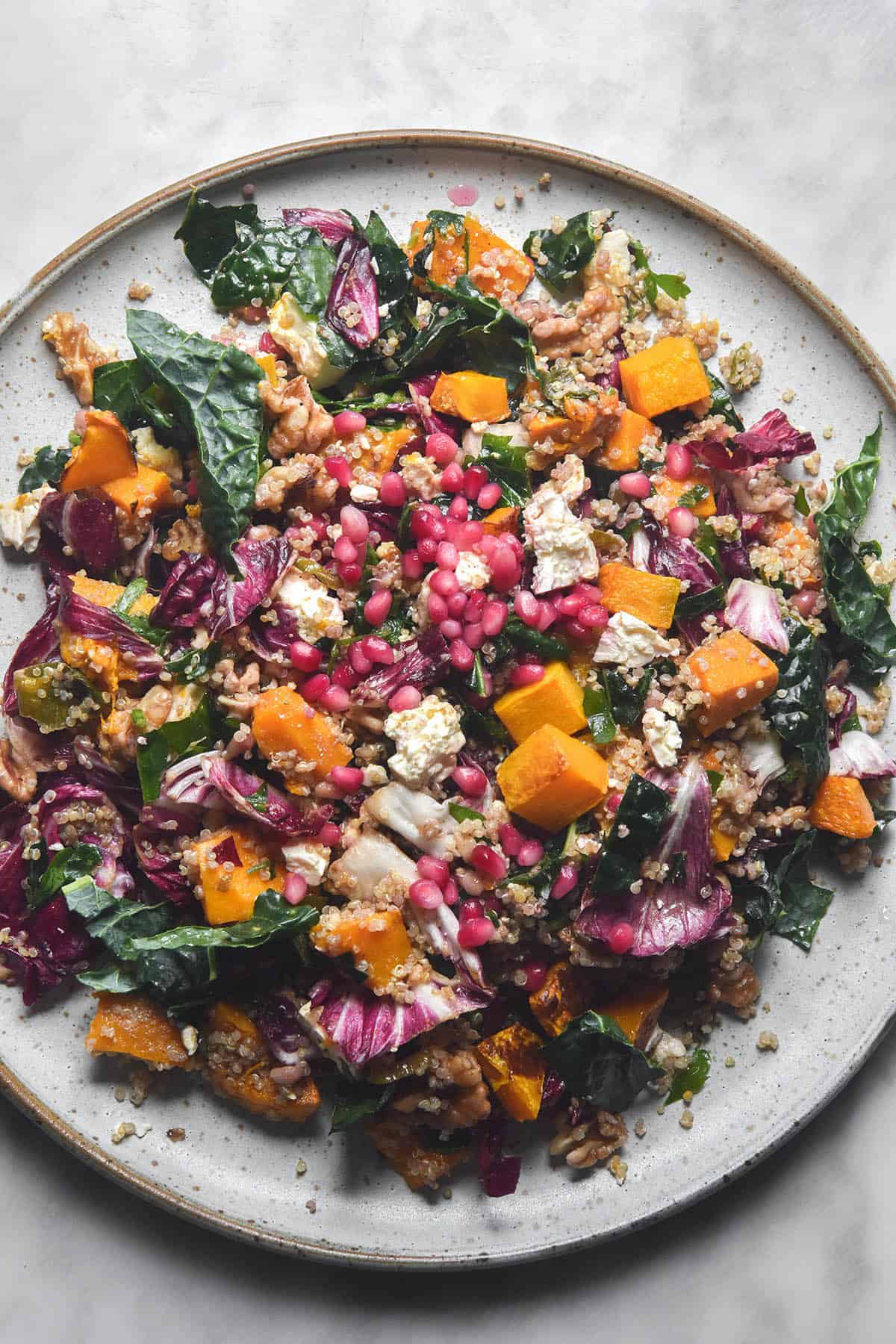
FODMAP notes
These FODMAP thresholds are current as of July 2025.
Monash has semi recently (as of November 2024) updated their entry for Japanese/Kent pumpkin. It is low FODMAP in serves of 75g and up to 161g. In serves of 162g or more, it contains moderate amounts of fructans. It was previously 500g per person.
Quinoa grains (white and black) remain low FODMAP in up to 500g servings per person per meal. It is also incidentally gluten free, so it caters to both low FODMAP and gluten free dietaries.
Feta is low FODMAP in serves of up to 500g per person per serve.
Tuscan kale is low FODMAP in 75g and up to 221g serves per person per meal. In 222g serves, it contains moderate amounts of GOS. This salad uses 50-100g Tuscan kale and serves 6-8, which keeps it well within a low FODMAP range.
Walnuts are low FODMAP in 30g serves or approximately 10 nut halves. In 31g serves, they contain moderate amounts of GOS. This means you could use 180-240g (one serve for 6-8 people).
Pomegranate seeds are low FODMAP in 42g (approximately 1/4 cup) per person per meal. In 53g serves, they contain moderate amounts of fructans. A salad that serves 6-8 people can safely contain 270-360g pomegranate seeds.

Tips for your roasted pumpkin salad
This salad is fairly straightforward to make and keeps well. However, there are a few tips to ensure your salad is a success.
The first and most important is not to overcook the pumpkin. Because the pumpkin will be tossed through the salad, it needs to be firm enough not to become soup. Cooked through but firm cubes of pumpkin will hold up better to being tossed.
On that note: small cubes of pumpkin are best here. Cubes that are too big are annoying to eat in a salad. Small bite sized little cubes can be scooped up in a spoonful with other ingredients, which gives you the full experience.
This festive dressing is a delicious and simple way to inject some Christmas spice. Depending on how much sugar you add to the dressing, it may not thicken much. That’s fine! Quinoa does a great job of soaking it up.
One last tip in regards to the dressing: make it according to your tastes and the acidity of your citrus. If you like a sweeter dressing, use a little extra sugar. If you don’t like things too sour, use the lesser quantity of lemon juice.
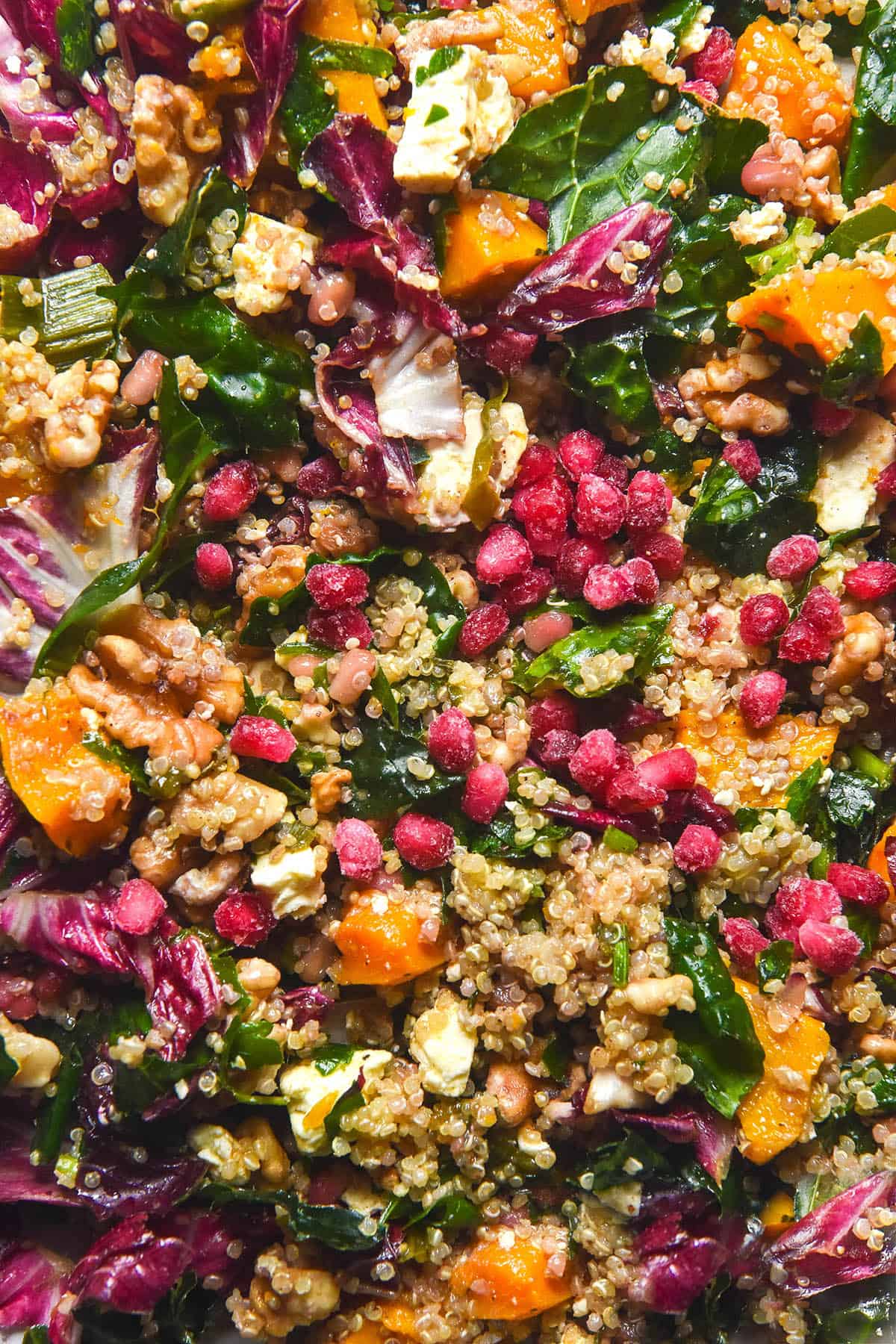
Substitution options for your roasted pumpkin salad
This roasted pumpkin salad is pretty amenable to substitutions. Beyond the pumpkin and quinoa, pretty much any ingredient can be swapped for another.
For a vegan option, choose a good quality vegan feta. If you don’t like feta, goats cheese (added to taste) is a suitable replacement.
For a nut free option, use pepitas or another seed. You can also simply omit the nut component, although it does add a nice textural element.
If you’re not a kale fan, you can use extra radicchio to compensate. And if you’re not a radicchio fan? Rocket or chopped spinach (added by sight rather than volume) would also work. No need to massage the green if it’s not kale, although parsley still benefits from a quick massage.
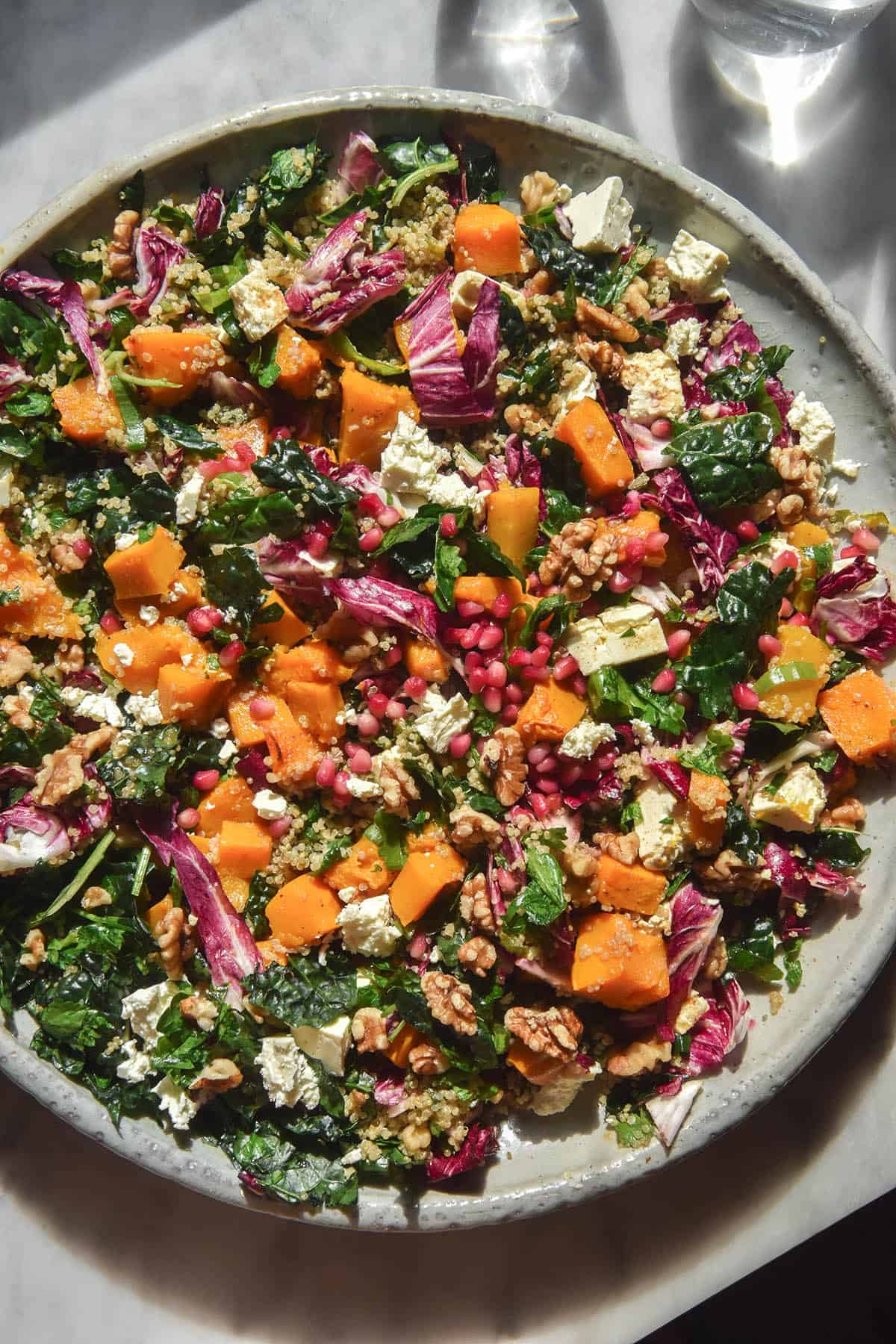
More low FODMAP salad recipes
- Crispy potatoes on a bed of zingy yoghurt topped with garlic infused chilli oil and herb nut salsa
- Radicchio salad with blue cheese and honey cinnamon walnuts
- Dukkah roasted carrot salad with zucchini hummus
- Vegan Vietnamese coleslaw with salt and pepper tofu
- Vegetarian ‘kind of’ Cobb salad
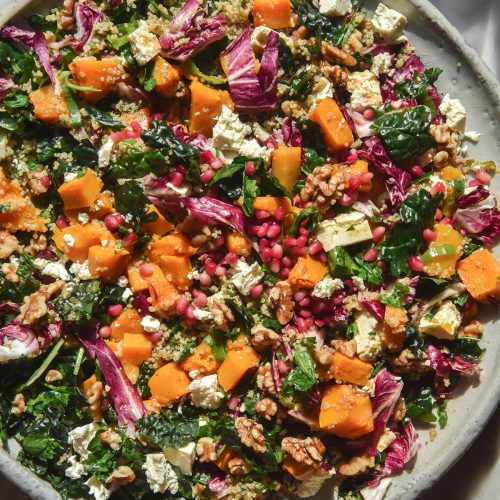
Roasted pumpkin salad with quinoa, pomegranate and feta
Ingredients
For the pumpkin:
- 500-750 g Japanese or Kent pumpkin chopped into bite sized pieces
- 20ml (1 tablespoon)* oil of choice
- Seasoning to taste
For the quinoa:
- 40ml (2 tablespoons)* oil of choice
- 1/2 bunch of spring onion greens chopped remainder used in salad
- 150-200g (3/4 – 1 cup* quinoa grains
- 500 ml (2 cups)* low FODMAP vegetable stock (you can also use water)
- Zest of 1 lemon juice used for dressing
For the dressing:
- 125 ml (1/2 cup)* orange juice
- 60-125 ml (1/4 – 1/2 cup)* lemon juice
- 50-75 g caster sugar or to your tastes
- 1/2 teaspoon ground cinnamon
- 1/2 teaspoon ground nutmeg
- Pinch of clove powder optional
- Seasoning to taste
To finish the salad:
- 50-100 g Tuscan kale
- 1/2 – 1 bunch flat leaf parsley finely chopped
- 20 ml (1 tablespoon)* olive oil or flavoured oil (garlic infused works well)
- Remaining spring onion greens chopped
- Handful of radicchio optional chopped
- 200-300 g Greek Feta, to your tastes goat’s cheese would also work
- 100-150 g walnuts, to your tastes (see FODMAP notes in body of post)
- 200 +g pomegranate arils, to your tastes (see FODMAP notes in body of post)
Instructions
To bake the pumpkin:
- Preheat the oven to 180C/356F. Place the pumpkin on a baking tray and drizzle over the oil. Use your hands to coat the pumpkin evenly, then season according to your tastes. Bake for 20-30 minutes or until the pumpkin is cooked through but still firm enough to hold shape in a salad. The cooking time will depend on how small your cubes are, so keep an eye on it.
To cook the quinoa:
- Add the oil to a medium pot over a medium heat. Once warmed, add the spring onion and cook for a minute or two until fragrant. Add the quinoa and toast it for a minute or so, stirring to prevent it burning or sticking. Add the stock (it will spit, so be careful) and stir to combine. Add the lemon zest and cook the quinoa for 7 or so minutes or until the grains unfurl. Ideally, the liquid should all have evaporated and there should be small holes in the surface of the quinoa. That’s OK if not – just drain off the excess liquid. Set quinoa aside and intermittently fluff with a fork.
To make the dressing:
- Combine the ingredients for the dressing in a small saucepan. Adjust the sweetness according to your tastes and the acidity of your citrus.
- Cook the sauce for 5-10 minutes. Depending on how much sugar you add, it might not thicken (and that’s fine, the quinoa will soak it up). Season to taste.
To assemble the salad:
- Place the kale, parsley and oil in a bowl and use your hands to massage for a few minutes until softened. You can also add a tablespoon or two of the dressing here if you like.
- Add all the ingredients except for a few pomegranate arils (to finish the salad) and the pumpkin to a large serving dish.
- Toss gently to combine and add the dressing to taste. You might not need all of it.
- Add any extra ingredients here as you see fit – more pomegranate, feta or walnuts.
- Add the pumpkin and very gently toss to combine. Finish with the extra pomegranate arils and serve.
- Leftovers keep well in the fridge for a number of days.
Notes
- The quantities of pomegranate and walnuts are designed to be low FODMAP per serve. If you have no FODMAP constraints, you can add these ingredients as you see fit.
- See the body of the post for FODMAP information and thresholds.
- Use pumpkin seeds in place of walnuts for a nut free option (or simply omit).
- For a vegan option, use a good quality vegan feta.

More delicious than I had anticipated! Thank you